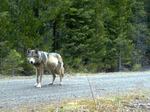Oregon’s wolf population had a growth year in 2019 but may have lost its most famous member.
OR-7,
a wolf that drew international attention
after wandering all the way from northeastern Oregon to the Oregon-California border in search of a mate, was not documented during the Oregon Department of Fish and Wildlife’s winter wolf count. He is presumed to have died.

Remote camera photo of OR7 captured on May 3, 2014, in eastern Jackson County on USFS land.
Courtesy of USFWS
The wolf, which was photographed in the fall, was the breeding male for the Rogue pack for many years. He is estimated to be 11 years old, which is considered to be very old in the wild.
“This is old for a wolf in the wild so it would be natural for him to die at this point,” ODFW spokeswoman Michelle Dennehy said.
Aside from the possible death of Oregon's most famous wolf, the ODFW annual wolf report released Wednesday had mostly upbeat news for those who want to see the predator population to thrive. It showed that the state's wolf population has increased by at least 15% in 2019.
State wildlife biologists counted 158 wolves during the winter count in Oregon, adding 21 more confirmed wolves from last year’s count of 137.
Dennehy said the count is based on verified wolf evidence and the numbers could be higher.
“It’s our minimum count based on verified wolf evidence like tracks, remote camera images, so we readily say there are likely more wolves out there than we counted because it’s difficult to count every single wolf,” Dennehy said.
The state also added six new packs for a total of 22 packs in the state. A pack is defined as four or more wolves traveling together in the winter. 19 of those packs met the criteria as breeding pairs.
Wildlife biologists documented over 15,500 wolf location data points by radio collar, remote camera surveillance, aerial, track and howling surveys. Most of the packs were located in the eastern part of the state in 32 separate geographic areas and 12 counties including parts of Baker, Douglas, Grant, Jackson, Klamath, Lake, Lane, Morrow, Umatilla, Union, Wallowa, and Wasco.
“Wolves continue to expand in Oregon, they’re on their own timeline but we’re continuing to see that growth. Again, much of it is still in North East Oregon but also have now a new breeding pair in Western Oregon this year which is the Indigo Pack,” Dennehy said.
The state documented seven wolf deaths in 2019, six of which were human-caused.
Four wolves were killed by car accidents on paved highways, one was euthanized due to severe injuries and infections and one was legally killed by a livestock operator under the depredation regulations.
The report also indicates no wolves were killed through state-sanctioned means in response to killing livestock. The last time that occurred in Oregon was 2015.
"Wolf killing went down, livestock conflicts decreased, and Oregon’s wolf population grew. This is good news, and more strong evidence that focusing on non-lethal measures to reduce wolf-livestock conflict works," Oregon Wild Wildlife Program Coordinator Danielle Moser said.
Livestock conflicts or depredation events decreased by 43%, as 16 confirmed cases were counted.